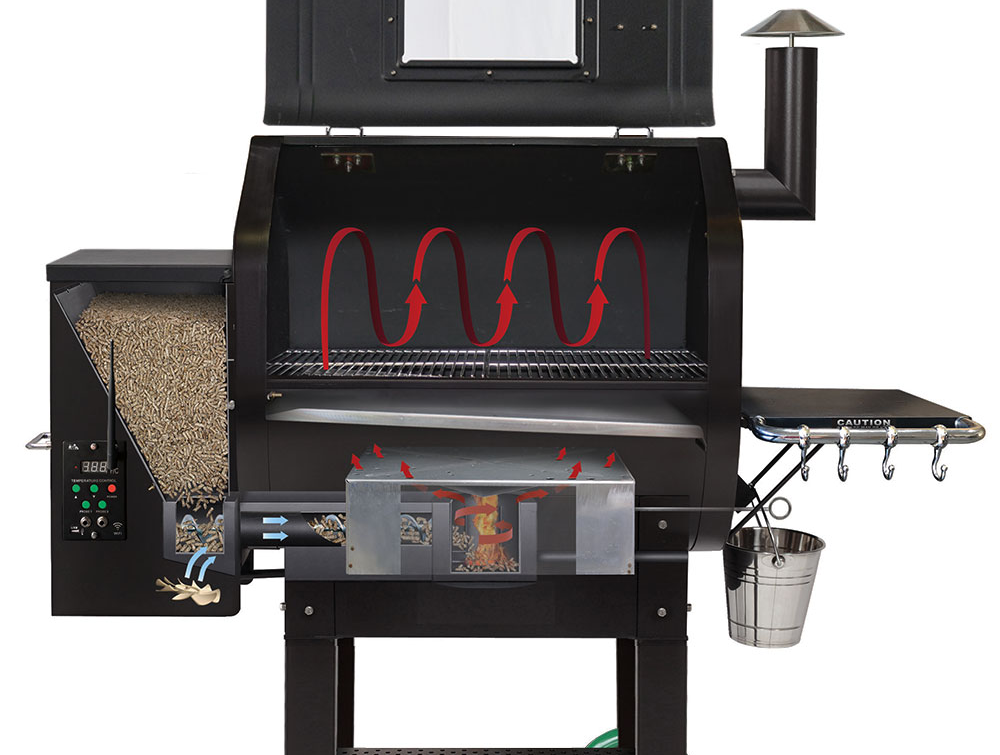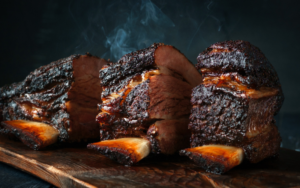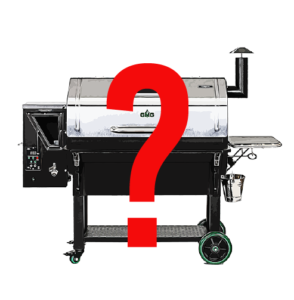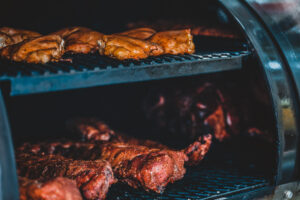Have you ever wondered what goes on in a pellet grill? Me too. This is an answer to my question when first learning about the craft. It just makes sense to share with you.
First...Power
A pellet grill requires electricity to operate. It is powered by a typical receptacle found in the home. It is turned on at the pellet grill with the press of a button or flip of a switch. Some models even allow you to start them with their respective proprietary app.
From this point on each pellet grill is a little different, but a start up sequence begins. The start up sequence is like a pre launch checklist. All systems begin to move in synchronization, and the pellet grill warms up to an operating temperature.
Simple and effective? Let's pop the hood
The systems at play look a little like this.
After being turned on, an auger begins to turn and bring pellets from the hopper down the auger tube to the fire box. Fire box also has the name burn pot, regardless, this is where the pellets light on fire.
Simultaneously, as the pellets are traveling down the auger tube to the fire box, an igniter rod is getting red hot. This will eventually light the hardwood pellets on fire. To ensure proper and efficient burning of the pellets, pellet grills use a combustion fan to stoke the fire.
The combustion fan also is responsible for convection, moving the hot air and smoke within the cooking chamber. The constant flow of heat and wood fired smoke is what gives food its signature flavor on a pellet grill.
Wait, it can't be that simple...
Let’s pause.
How does the pellet grill know how to maintain temperature? One of the more difficult things to do in an offset smoker is maintain temperature.
The answer lies within the controller. The controller has a simple outward user interface allowing you to set the temperature you desire.
Most pellet grills today are being made and outfitted with PID controllers. PID stands for Proportional Integral Derivative.
The short is that based on a control variable (the set temperature), and the feedback variable (the pellet grills internal temperature), multiple systems will work to maintain the control.
The start up of the grill may set the temperature at 180 degrees, and it will continue at that temperature by constant feedback from the temperature sensor within the cooking chamber.
If the temperature falls below 180, the feedback causes increased fan speed and more pellets in the fire box to increase the temperature.
If the temperature rises above 180, the feedback from the temperature sensor causes lower fan speeds and fewer pellets in the firebox.
The first pellet grills, and some still on the market today use a time based temperature control. You essentially set the dial to the desired temperature, and the pellet grill feeds the firebox at a preset interval of time based on the temperature you have chosen.
This is still an effective method to manage temperature, just not as accurate as a PID controller.
This feels right
Okay, back to it.
Can we also take a moment and point out that all the mechanics described thus far are done without any extra work by you. By design all you have to do is tell the pellet grill what temperature it should be at.
After the pellet grill warms up, it’s waiting for input from you. At this point, you can set the temperature anywhere from 160 – 500 (for most pellet grill brands).
You set the temperature of the grill to 250 degrees, for example. This is done manually at the grill’s outward interface or with a smart phone app.
This interface may look like a dial, arrow buttons, a touch screen, or a combination of each. Most pellet grills on the market also offer a phone app.
This allows Bluetooth, WiFi, or both to talk to your grill from your phone. Once paired, you can control your pellet grill from your phone.
Some brands offer remote start up and shut down, but nearly all allow you to control the temperature from the convenience of wherever you are. This comes in handy when you are completing long smokes on brisket or pork shoulder.
There is no need to have complicated systems at play here. The appeal of a pellet grill is making great wood fired barbecue without the expertise of running and maintaining an offset smoker.
The craft of barbecuing is made more straightforward with a pellet grill, and anyone can do it, at any skill level.
A pellet grill is all you need for your backyard, it gets you outside, and it gets you crafting great food. Its design allows you to sear, smoke, barbecue, roast, grill, braise, bake, and…relax.
Not many outdoor grilling systems give you time back. So, with this knowledge isn’t it time to get out there and smoke something to be proud of? While you’re at it, share with as many friends and family possible.

Pellet Grill Components: Extended Explanation
Power
Pellet grills need to be plugged into a power source in order to operate. A typical household receptacle is all it takes. It’s a bonus if you have an outdoor plug in. For extra credit you have a receptacle within 2 feet of your pellet grill. It’s convenient at that point (no trip hazard), and looks nicer too.
Here’s the thing, some may see it as a drawback to pellet grills, but I argue this is what makes them better than other grilling systems. The electrical power need for a pellet grill powers the control board, the auger motor, the fan motor, and various sensors. Not one of these components creates a very big draw.
The result is a highly efficient use of electricity. It’s not going to cause your electric bill to skyrocket.
So, maybe the drawback is having to plug your grill in. Maybe its more of a drawback if you have to run an extension cord to it. But, it’s what makes it unique and better than any other grilling system out there. It’s a small determining factor when considering the versatility a pellet grill offers.
Pellet Hopper
The pellet hopper is usually situated right next to the cooking area of a pellet grill. This is because at the bottom of the hopper is where the auger takes the pellets to the firebox. The hopper can vary in size, and is usually proportional to the cooking area inside the pellet grill.
Some pellet grills have disproportionate sizes, but is less common in today’s pellet grills. The thought is that providing a large hopper releases the stress of having to refill it. However, many seasoned pellet grillers like to challenge themselves and experiment with different flavors of hardwood pellets.
If a hopper is too big it becomes cumbersome to change the pellets out. There are brands and models that make this easier with a feature called a
The pellet hopper is where the pellets reside and await their turn for the firebox. When taken to the firebox via a ride on the auger they burn completely giving off that nice blue smoke that embues the meat within the cooking area.
Hardwood pellets
Wood pellets matter. This is absolutely true, and most pellet grill brands understand this very well. Most brands manufacture their own line of pellets. It’s important to note the term hardwood. Most, if not all wood species used in pellet grills are from a hardwood variety…or they should be.
Hardwood species of wood simply contain less sap and resin. Though it comes down to how you process wood pellets, hardwood species naturally contain less contaminants. Don’t be fooled by fancy infused wood pellets or gimmicky claims for hybrid varieties.
Hardwood species give you the signature flavor profile found in great barbecue. Finding the right combination of seasoning and wood flavor can elevate your meat to new heights.
Hardwoods like Alder, Cherry, Oak, Apple, Pecan, Mesquite, Hickory, Maple (to name a few) imbue a unique flavor to chicken, beef, pork or whatever is on your smoker. Wood fired food just tastes better.
These hardwoods are harvested, then go through a large chipper. The chips are turned and dried. Once they are dry with little moisture content they are pulverized into a fine saw dust. From there, tons of pressure is applied through a die and pellets are formed into their signature shape and size.
Softwood pellets are commonly used in wood pellet stoves used for heating homes. Softwood has a higher BTU rating, meaning they burn hotter, and it contains more lignin. Lignin is a natural polymer found in the cellular makeup of all trees.
This polymer is actually what allows pellets to hold their shape when they are pressed and formed. Softwood pellets have the potential to contain more contaminants as well. It’s best to avoid softwood pellets in your pellet grill.
Auger
An auger is a metal rod with spiral grooves machined out, which when rotated moves a medium from one location to another. An auger is seen in many industries. For it to have such a unique application in a grilling system is profound.
There is an opening at the bottom of the pellet hopper that accepts the pellets into the auger. The auger in a pellet grill is surrounded by a hollow tube or housing traveling to the fire box. This allows the pellets to travel down the auger to the fire box in a controlled manner.
The grooves machined into the auger are a specific size to allow the right amount of pellets to be deposited in the fire box. The auger is attached to a motor that usually sits underneath the pellet hopper. As the temperature sensor talks back to the main controller, the auger is either turned on or told to wait.
Obviously simplifying the mechanics, but when the grill needs to increase temperature the auger moves more pellets to the fire box. Inversely, when the temperature needs to maintain at its current temperature or cool off a bit, the auger lays in wait, not moving any pellets to the fire box.
The auger is in synch receiving signals from the controller based on constant feedback all in attempt to maintain temperature that you determine. Some, if not most pellet grills have a purge function. This allows you to clear jams from the auger tube or manually push pellets into the fire box.
Speaking of jams, it’s a very real thing that happens to pellet grills. It happens when the pellets orient themselves in such a way that they jam between themselves, the auger, and auger tube or housing. The purge manually spins the auger to help clear the jam.
A jam is also caused by cheap hardwood pellets or wet hardwood pellets. In both cases they tend to disintegrate after swelling, or just flat out crumble creating this clumping dust.
Firebox
The fire box is referred to as the burn pot in some brands, but regardless of the name it does the most important thing in a pellet grill. When you look into the pellet grills cooking area, it’s located in the middle and bottom of the grill. The shape of the fire box is square with circular cutout.
Within the circular cutout we see the igniter rod, and a short cylinder that accepts pellets from the auger tube. The fire box contains the igniter, which is a metal rod that upon receiving a signal from the controller turns red hot.
This is very similar to how an oven or furnace works. An igniter rod after receiving a signal begins to glow red hot because of the electricity allowed to flow through it. In the oven as gas flows past the igniter, it ignites into a flame, and lights the burners on the bottom of the oven.
As a glowing red hot igniter burns hardwood pellets in the fire box, they ignite. When they do they create smoke, heat, and fire. The fire box also has slits cut around the cylinder. With a fan positioned under the fire box, this aids in airflow distribution.
The fan, also receiving a signal from the controller stokes the newly formed fire. This convection effect surrounds the cooking chamber with heat. That heat is held within the cooking area before it escapes through the smoke stack…or if you open the lid of course.
The fire either burns in a calm manner when the temperature is maintained, or in a rage when the fan begins to add more airflow to the fire. This phenomenon results in a hotter burning fire, thus increasing the temperature.
As we know this constant feedback from the temperature sensor to the controller maintains a consistent heat.
Fan
We started talking about the fan a little bit when describing the fire box. The fan is a really important component of the pellet grill. It allows the grill to increase or decrease temperature quickly. It also serves to create convection.
First, looking at the increase or decrease in grilling temperature. A pellet grill will have one or more fans. The fan that stokes the fire, meaning it maintains the fire, is called a combustion fan. It gets that name because it aids in the combustion between the hardwood pellets and the igniter.
Those pellet grills with more than one fan, are positioned near the pellet hopper to create air flow within the pellet hopper itself. The theory here is that the positive airflow in the hopper prevents burn back. Burn back happens when the pellets in the auger tube catch fire or reach the smoke point.
This is due to a build up of ash or incompletely burned pellets in the fire box. When this occurs you will see a fire in the auger or the hopper (in extreme cases), potential for dangerous pressure to build up, and the easiest way to prevent this is to keep a relatively ash free pellet grill.
The second function of a fan in a pellet grill is convection. Convection is circulation of heat. More specifically, what happens in a pellet grill as heat is created in the fire box, the fan moves the hot air. The hot air naturally displaces cooler dense air and rises.
When the hot air rises and hits the top of the cooking chamber, the hot air cascades back down over the grilling grate hitting your cut of meat. There is a constant circulation of hot air, that contains wood fired smoke, which is the ultimate appeal to pellet grilling.
With the fan, the wood fired flavor is imbued to anything you have on the grates. The smoke flavor is constantly hitting the food, and leveling up the flavor profile.
Controller
The controller on a pellet grill is the brain. It tells the components we have discussed thus far to take a particular action. There are two types of controllers. There are PID controllers and time based controllers.
A PID controller is the most advanced type of controller. These types have LED backlit screens, digital interfaces, or more traditional analog buttons or knobs. Regardless of the user interface that you see on your pellet grill, with a PID controller your temperature will be more closely maintained.
A PID controller takes the temperature you desire. Let’s say you desire a temperature of 250 degrees. The temperature sensor within the pellet grill speaks directly back to the controller. The control variable, being the temperature, must be maintained.
With the feedback in hand, the controller then places an action on the auger, fans, and igniter. As the temperature fluctuates under or above the set temperature of 250 degrees, those components just mentioned will work in synchrony to achieve the temperature.
This technology does a couple things for pellet grill owners. There are less temperature fluctuations even in the presence of extreme weather. Temperatures are maintained within a +/- 5 degrees margin. The pellets are burned more efficiently, meaning they are burned more completely.
The drawback to PID technology is less smoke, which has empowered many pellet grill manufacturers to enable features that create smoke separate of the temperature maintenance. There is less smoke because the pellets are being used efficiently. Now, less smoke does not mean no smoke.
There is still wood fired flavor imbued, however it may not be as pronounced as the smoke flavor experienced with an offset smoker.
The other type of controller is time based. You turn a dial to a set temperature. That temperature you select determines the time interval in which pellets are driven into the firebox. If we choose 250 degrees for example, the pellet grills controller will deposit pellets into the fire box at a preset interval of time.
This works well, and many pellet grills still use this technology. You can expect to have wider temperature fluctuations, but this experience is closer to a traditional offset smoker. The temperature is still more consistently maintained but with a +/- 20 degree on average margin.
Time based controllers also have what is called “P” settings. The P stands for pause. Because the controller moves pellets into the fire box at a set time interval based on the temperature selected, the controller has a hard time accounting for temperature extremes.
The P setting can pause the influx of pellets to the fire box overriding the time interval based on the set temperature. This is a more advanced feature but is used in temperature extremes. Think about 110 degree Arizona climate, or -20 degree climates in Minnesota.



